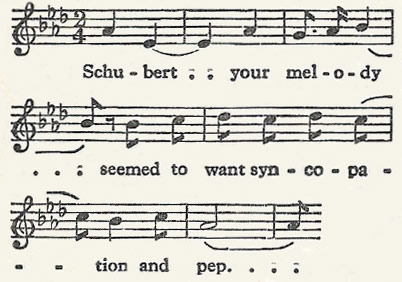syncopation

Improvement introduced into a theme from Schubert's 'Unfinished' Symphony. (The London Revue Joy Bells during the early 1920s.
Syncopation is an alteration of the expected rhythmic emphases. In other words, its a displacement of either the beat or the normal accent of a piece of music. It might involve accenting (see accent) a weak (instead of a strong) beat, or replacing strong beats with a rest (silence). For example, in classic ragtime tunes, the accents are not on one-two-three-four but on one-two-three-four. Syncopations disturb the regular, predictable pattern of strong and weak beats (as indicated by the time signature).
Among other musical genres in which syncopation is commonly used are jazz, funk, reggae, hip-hop, progressive rock, ska, dubstep, samba, and dance music. In the form of a backbeat, syncopation is found in almost all contemporary pop music.
Another way of describing syncopation is rhythmic contradiction. It can be brought about in various ways: (1) By the occurrence of rests on the normally accented parts of the measure, with notes on the unaccented. (2) By notes being first sounded on the normally unaccented parts of the measure and then merely held on over the normally accented parts. (3) By the introduction of a stress mark over notes that would normally e unstressed. In any case, the rhythmic effect is the same: there is a shifting of accent.
All composers of all periods have used syncopation, and, being a very simple and natural device, it often occurs in the folk song music of certain races. The Scottish Snap is an instance of syncopation, though here the normal divisions of the beat, rather than those of the measure, are contradicted. (but this a little more than a matter of notation, for a beat is really a sub-measure.)
The prevalence of syncopation in African music, and hence in that of African-American music, is an important influence in the history of jazz and of twentieth-century popular music generally.


